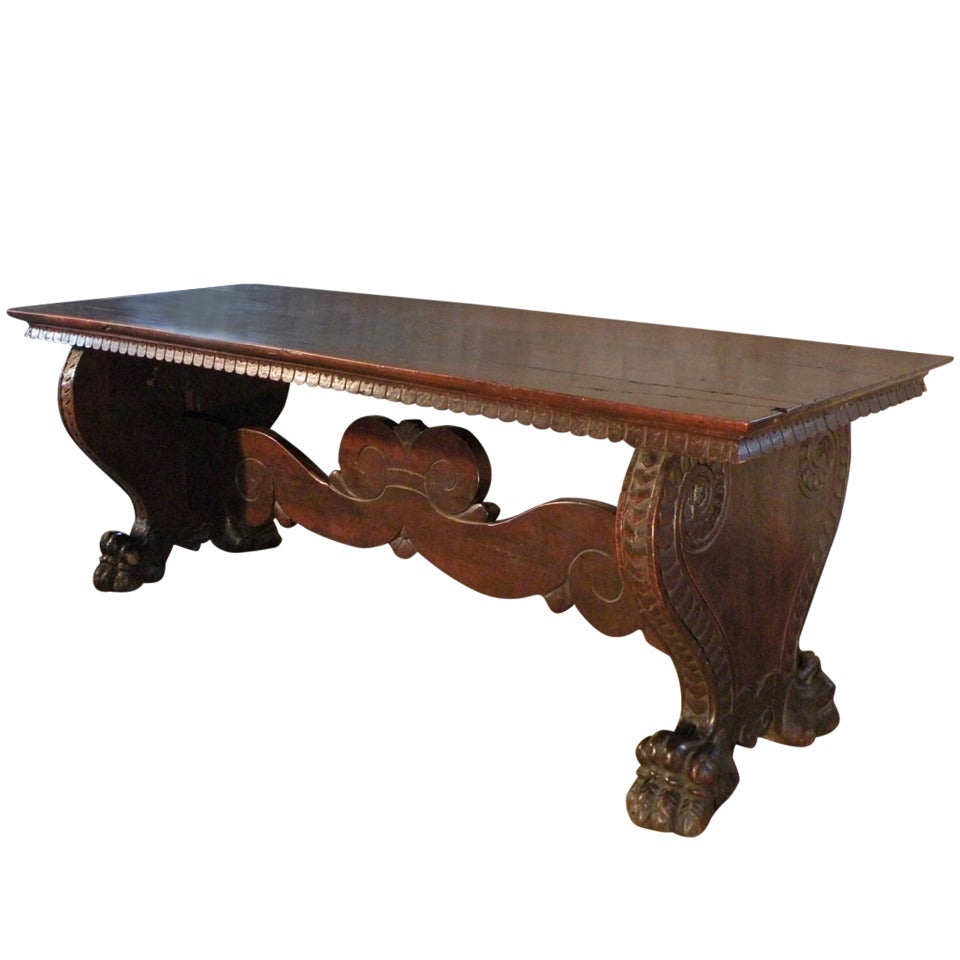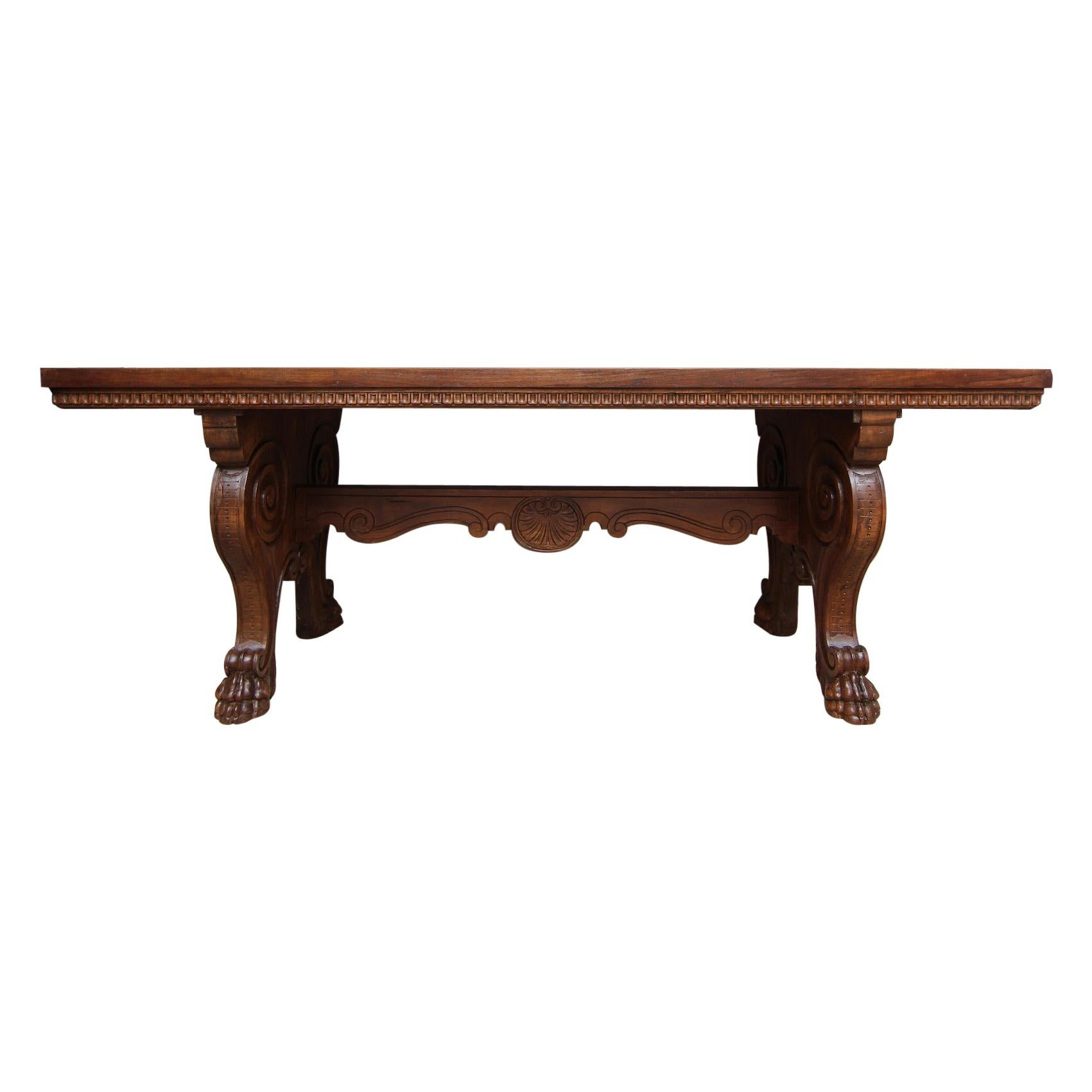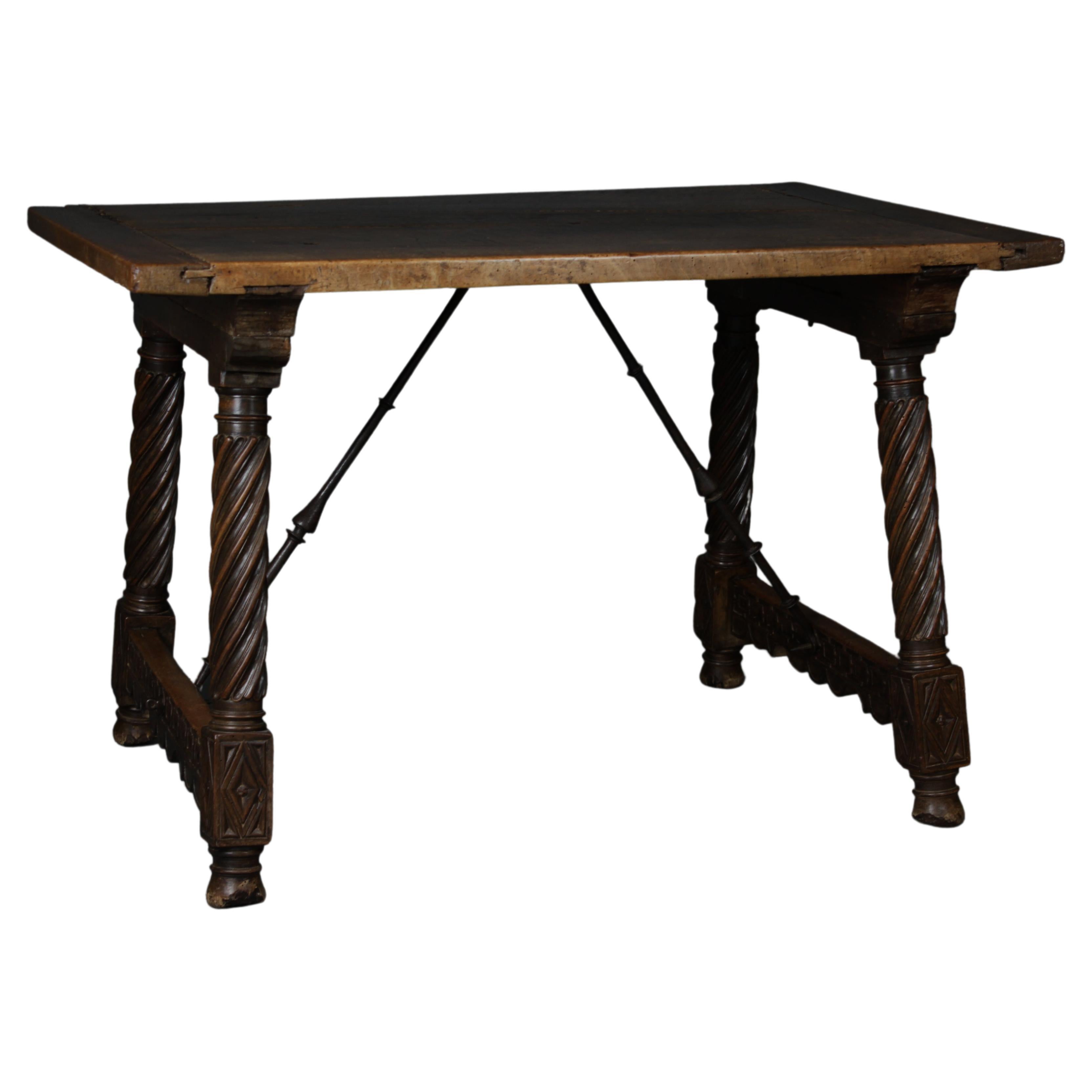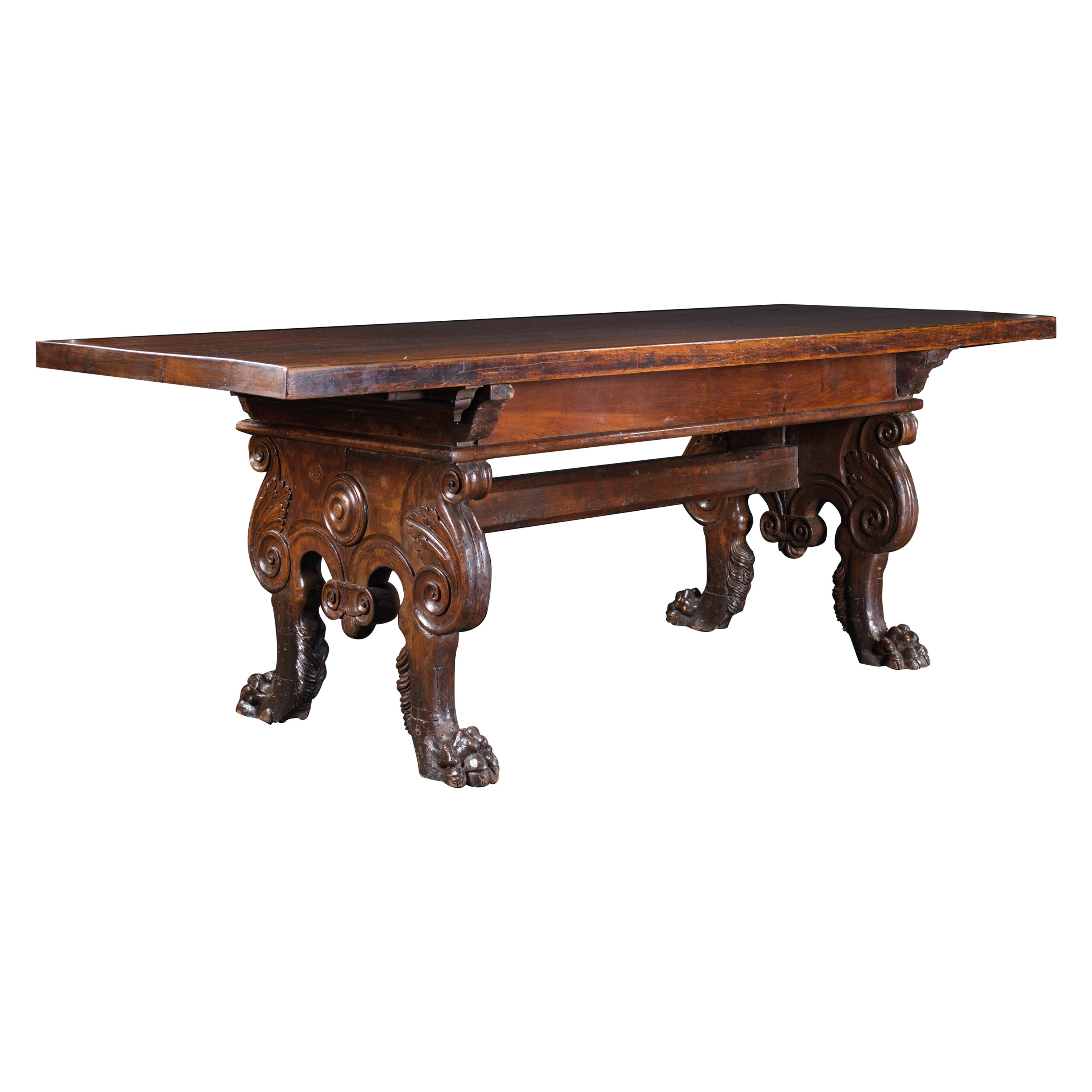Items Similar to Table, Drawleaf, 18-Seat, 16th Century, Italian, Renaissance, Walnut, Iron
Want more images or videos?
Request additional images or videos from the seller
1 of 8
Table, Drawleaf, 18-Seat, 16th Century, Italian, Renaissance, Walnut, Iron
About the Item
This massive 18-seat table has many features which are typical of drawleaf tables that were made in the last quarter of the 16th century. Early continental drawleaf tables rarely come onto the open market and the massive extended length, original top, leaves, base and iron fittings are exceptional features of this particular table. It is also unusual for drawleaf tables of this length to have four legs as they generally have six. However the four legs are a massive 14cm in diameter at their maximum so they are strong enough to support the top, more practical as there are no central legs to get in the way and the aesthetic is more pleasing. The drawleaf feature is very practical enabling the table to extend to almost double its closed length and creating versatility through multifunctional use as a large or small dining table or centre table or writing table. The drawleaf mechanism is simple and robust as, once the catches are released the leaves pullout / pull-out and push back. The walnut has a beautiful configuration, has mellowed over the years into a warm, honey colour and retains an exceptional lustrous patina. The table is in good, usable condition with typical wear and tear, blemishes, marks and natural shrinkage gaps between planks.
The top is made from two planks of walnut, with a later, small, walnut butterfly patch to prevent further shrinkage, joined with cleated ends. The top unusually retains four original iron escutcheons and catches on the leaves along each side which is an exceptionally rare decorative feature as they are not necessary for the drawleaf mechanism to work or for the leaves to remain in place once closed. The leaves are made from two pieces of walnut with cleated ends and there is graduating shrinkage on both which could be filleted. The lopers for the drawleaf mechanism are in good condition and two stoppers are missing on one side. The frieze is decorated with classical moulding characteristic of the period. The large 14cm diameter maximum, graduating, ring and baluster turned legs are decorated with three rows of delicate punch carving. The square stretchers have moulded decoration. Standing on bun feet, two are 19th century replacements. Exceptional original colour and patina.
Measures: Extended length 346 cm., 136¼ in., (11ft. 4¼ in.) closed length 188 cm., 74in., (6ft, 1in.) Height 83 cm., 32¾ in., width 74 cm., 29¼ in.,
Top thickness 2.5cm., maximum leg diameter 14cm
The most common model of dining table in the medieval and Renaissance periods was of trestle construction, consisting of large oak or elm boards resting on a series of central supports. As the long tops were very heavy it was too cumbersome to easily move them so the drawleaf model superceded the trestle. It introduced a simple device which enabled the table to be extended to nearly double its closed length. Although relatively few of these tables survive there are numerous references to them in 16th and early 17th century inventories in which their values demonstrate that they were regarded as valuable possessions. Stools were arranged under the tables when not in use, with their tops outwards, supported on the stretchers. The immovable nature of these tables led to them descending through many generations in the same family, and Evelyn observes in a familiar passage that both in hall and in parlour long tables ‘were as fixed as the freehold’. This is further evidenced by the inscription: ‘A harelome to this hous for ever’ and the date ‘163..’ with the last figure missing on one leg, on a long table with four legs which was removed from a house in Lancashire.
Provenance: Private Collection.
- Dimensions:Height: 32.68 in (83 cm)Width: 74.02 in (188 cm)Depth: 29.14 in (74 cm)
- Style:Renaissance (Of the Period)
- Materials and Techniques:Walnut,Metalwork
- Place of Origin:
- Period:
- Date of Manufacture:1580-1620
- Condition:Wear consistent with age and use.
- Seller Location:BUNGAY, GB
- Reference Number:1stDibs: LU3867315799092
About the Seller
5.0
Vetted Seller
These experienced sellers undergo a comprehensive evaluation by our team of in-house experts.
Established in 1985
1stDibs seller since 2018
84 sales on 1stDibs
Typical response time: 9 hours
- ShippingRetrieving quote...Ships From: BUNGAY, United Kingdom
- Return PolicyA return for this item may be initiated within 7 days of delivery.
More From This SellerView All
- Monastery Trestle Table One Plank Walnut Biscione Milan Armorial 14-16 seat 10ftLocated in BUNGAY, SUFFOLKA massive, 14-16 seater, antiquarian, milanese, renaissance-revival, monastery, trestle table with 10ft long, 4 ¼” thick, single plank walnut top & oak trestl...Category
Antique 18th Century Italian Renaissance Revival Dining Room Tables
MaterialsOak, Walnut
- Cassettone or Bureau-Chest, Late 16th Century, Italian Renaissance, WalnutLocated in BUNGAY, SUFFOLKExceptional museum quality, Italian, renaissance walnut cassettone with fitted bureau in the upper part & exceptional Bambocci carving, Lombardy. This magnificent cassettone exudes the character and quality of the finest, late-Renaissance furniture. Late 16th century, Northern Italian furniture often had the sides, legs or angles, 'a Bambocci', incorporating carved figures which were unique sculptures in their own right. The putti on this cassettone are beautifully carved and of sculptural quality. Each angel has one arm raised to heaven, a poignant touch. Showing customary signs of wear from time, the lion’s paw feet make a great statement. This cassettone was conceived to have visual impact through the quality of the carving, as well as being very practical with the writing compartment fitted in the top part. It has survived in very original condition with a few small repairs and losses, and the color and patina are warm and lustrous. This cassettone was illustrated in one of the seminal works on Lombardy furniture in the 1969 and has been in two renowned collections. The hinged top in two sections faced with a solid moulded edge. The front part has a fall front and opens to reveal a writing compartment. The fall front retains its original lock and is concealed with a false drawer which is above three drawers. All with moulded panels, escutcheons and retaining the original iron handles. The front ends have exceptional, bambocci, carved putti raising their arms to heaven above trailing foliage. Standing on magnificent lion...Category
Antique 16th Century Italian Baroque Furniture
MaterialsWalnut
- Table, Centre, Dining, Writing, Walnut, Octagonal, French, RenaissanceLocated in BUNGAY, SUFFOLK- This table is a rare and attractive octagonal form with characteristic Renaissance legs. - It can serve as centre, dining or writing table. - The...Category
Antique 1620s French Renaissance Center Tables
MaterialsWalnut
- Cathedra or Throne Chair, Late 16th Century, French Second Renaissance, WalnutLocated in BUNGAY, SUFFOLKA moulded cornice sits above the high, panelled back with fluting and applied roundels. The later, metal pin on the left edge releases the central, moulded panel in the back which retains its original hinges. When the pin is removed the panel can be lowered, revealing a large area behind. The scroll arms are supported by tapering turnings which can be compared with mid-16th century benches of the nave such as those in the churches in Gerberoy and Coivrel which are in Oise, the Piccardie region of Frances. The panelled, box seat has later 18th century hinges...Category
Antique 16th Century French Renaissance Armchairs
MaterialsWalnut
- Table, 18th Century, Italian, Baroque, Walnut, Narrow, One Piece TopLocated in BUNGAY, SUFFOLKA rare, narrow, Italian, baroque, walnut, cabinet or sidetable. This table has unusual, narrow proportions and was probably originally conceived as a stand for a table cabinet or ...Category
Antique Early 18th Century Italian Baroque Center Tables
MaterialsWalnut
- Pair of Walnut Armchairs, Late 16th Century, French Renaissance, with Ram Mask CLocated in BUNGAY, SUFFOLK"This rare pair of upholstered open armchairs relate to examples in museum collections in France, the USA and the UK. Few pieces of Renaissance furniture featuring ram’s head motif arm terminals survive as the chairs would have been in the ownership of the elite symbolising leadership and authority. The condition of these armchairs reflects their age and use and they have a rich colour and lustrous patina. The form of these chairs is characteristic of a stereotypical Renaissance model. The upholstered section of the backs are upholstered in wool with applied 17th century floral needlework faced with gilded studs and supported by square section uprights. The channelled tablet and stylised rosette incised curved arms terminate in acanthus capped carved rams' masks and are supported by column turned uprights headed by an entrelac collar. The ram is a symbol of leadership and authority and it also determination, action, initiative, and Aries, the first sign of the Zodiac. The seats are upholstered in wool with applied 17th century needlework faced with gilded studs and supported by tapering column/ring turned front legs and square section back legs. Some of the stretchers with moulded detailing. Standing on front ball feet. Exceptional original colour and patina. Henri II 1550-60. Condition: The chairs are both sturdy with exceptional colour and patina. One armchair with a splice on the rhs back leg and replaced but period front and lhs stretcher both bearing old nail marks, two other replaced stretchers and the back uprights bearing old nail marks indicating that they were upholstered at some point. The other armchair with an old repair to a break in the right back leg and an old patch near the end of the leg, replaced but period back and lhs stretcher, small patch to bottom of lhs arm where it meets the support. Old worm marks and some losses. Considering the age of the armchairs, these repairs and replacements are not unusual and consistent with the repairs on the related armchairs in museum collections. They suggest that the chairs either fell backwards at some point or someone leant back while sitting in them. Back Height 107cm, 42in, Seat Height 59.5cm, 23½in Width 60cm, 23½ in, Seat 59cm, 23¼in Depth including arm 59cm, 23¼in, Seat 49cm, 19¼in Provenance: Deaccessioned by The National Galleries of Scotland Bearing an old transport label from Alain Moatti (French architect) to Mrs Katz, London Literature: Related to : There are comparable armchairs in international museum collections dated to the second half of the 16th century. Most share the following characteristics with the above pair, the form, the ram's mask carved to the end of each arm, the curvilinear outline of the arm rests, the ring turned front legs as well as the plain square section back legs and plain stretchers. 1. Two stained glass windows...Category
Antique 16th Century French Renaissance Armchairs
MaterialsWalnut
You May Also Like
- Italian 16th century Renaissance Walnut Trestle TableLocated in Troy, NYAttractive, rare Renaissance trestle table of typical, bold design and beautiful rich color. Provenance: Metropolitan Museum of Art, NYC.Category
Antique 16th Century Italian Renaissance Dining Room Tables
MaterialsWalnut
- 19th Century Italian Renaissance Revival Writing Desk Made of WalnutLocated in Dusseldorf, DEA 19th century Italian writing desk in renaissance revival style made of solid walnut. The table can be used as a writing desk or as a dining table. Both sides look the same. ...Category
Antique 19th Century Italian Renaissance Revival Desks and Writing Tables
MaterialsWalnut
- 16th Century Spanish Walnut Writing Table, Circa 1580Located in Brugge, BEAn impressive and illustrated 16th century Spanish walnut writing table, exemplifying unparalleled craftsmanship. The exquisite detailing on the legs, stretchers, and even on the bot...Category
Antique 16th Century Spanish Renaissance Desks and Writing Tables
MaterialsWalnut
- Italy 18th Century Baroque Walnut Organic Shape Table DeskLocated in Brescia, ITThis walnut rectangular Tuscany table, has been hand made in Lucca (Tuscany, Italy) in 1760 circa. Its elegant shape, with the black border, makes this ...Category
Antique Mid-18th Century Italian Baroque Dining Room Tables
MaterialsWalnut
- 19th C Style Solid Italian TORINO Walnut Table Renaissance Dentil custom sizeLocated in Encinitas, CAOur exclusive “TORINO” carved leg table with Renaissance style dentilated detail on the apron and authentic Renaissance style finish - The Italian Art...Category
2010s Italian Baroque Revival Dining Room Tables
MaterialsWalnut
- 16th Century Florence Palace TableLocated in Saint-Ouen, FRIn the beginning the table was a movable furniture with removable feet, easy to build and disassemble. Most of the 15th and 16th century tables are built following the Roman cartibula principles that is a plate standing on two large stands secured by a crossbar. The lengthy and elegant plate of this Italian Renaissance palace table...Category
Antique 16th Century Italian Renaissance Dining Room Tables
MaterialsWalnut
Recently Viewed
View AllMore Ways To Browse
Table 18 Century
Antique Dining Table Square
Square Dining Table Antique Furniture
Square Antique Dining Table
Antique Square Dining Table
Rare Antique Dining Table
Antique Square Dining Room Table
Four Seat Table
Dining Tables 32
Patina Dining Table Italy
4 Seater Table
4 Seat Table
Small Table Seat
Italian Iron Dining Table
Very Large Antique Dining Table
Very Large Antique Dining Room Table
4 Seater Dining Table
4 Seat Dining Table





